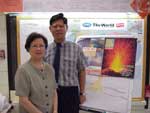Overview Now more than ever, safety tops the list of classroom concerns. How can students face threats of disaster and feel prepared to deal with emergencies? Buddy, Are You Ready? introduces older students to natural disasters by reading stories about volcanoes, earthquakes, floods and hurricanes. Exploring safe behaviors from both scientific and historic perspectives lets students understand what to expect in a catastrophe. Practicing safe evacuation procedures leads to cross-grade sharing of information. By role modeling and explaining safety tips, older students become trusting guides to their younger Safety Buddies. At the schoolwide Earth Day Learning Festival, posters about Evacuation Routes and materials on Emergency Safety Kits help parents and the school community realize that planning is the best way to deal with potential disasters.
|
Classroom
Activities
|
Community
Activities
|
Career
Activities
|
||||||||||||||||||||||||||||||||||||||||||||
|
|
|
|
Learning Standards English Language Arts |
|
| • | Employ and understand the writing process. |
| • | Conduct literature circle for effective discussion and making connections. |
| • | Utilize different technologies to complete and enhance work, such as analyzing, interpreting, and evaluating literature, as well as tracking errors in writing. |
|
Learning Standards Math |
|
| • | Understand money value. |
| • | Engage in graph plotting. |
|
Learning Standards Science |
|
| • | Conduct a scientific inquiry. |
| • | Employ equipment and tools to carry out investigation. |
| • | Conduct a volcanic experiment. |
| • | Present result and information effectively. |
|
Learning Standards Social Studies |
|
| • | Engage in historical and social issue analysis. |
| • | Make connection between past and present. |
|
School to Career Competencies |
|
| • | Practice Communication and Literacy Skills. |
| • | Organize and Analyze Information. |
| • | Problem Solve. |
| • | Use Technology. |
| • | Experience Role of Teacher. |
Assessment Teacher and students hold regular conferences for Literature Circle responses and reflections. Math and science skills are evaluated by classroom quizzes and tests. Cooperating teachers meet periodically to discuss students' progress.
Software or Materials Used For research: newspapers and Internet; for posters & computer slide shows: digital camera, art supplies and Microsoft Office; For math software: Graph Club by Tom Snyder Productions; for literature: Book List on Natural Disasters.
Web Sites Web Sites List on Natural Disasters
Keywords Cross-Grade Tutoring, Disaster, Earth Day, Earthquake, Emergency, Evacuation, Flood, Hurricane, Literature Circle, Mentoring, Mt. Vesuvius, Pompeii, Safety, Service Learning, Volcano, Web Quest
Final Words Trust building is a key to Buddy Are You Ready? Reading and sharing survival disaster stories increase older students' confidence. Both mentors and their safety buddies begin to understand that it pays to prepare for emergencies. Parents are also relieved and grateful that their children are learning how to act safe to be safe.
Teacher Tip The several student friendly web sites on natural disasters are particularly effective. It's amazing how much good material is out there if you just search for it. Be sure to go to FEMA's online safety tips for kids.

E-mail contact Ronnie Ho rho@boston.k12.ma.us; Janet Shih jshih@boston.k12.ma.us
Teacher Bio Janet Shih, a first grade bilingual teacher at the Josiah Quincy Elementary School, has been teaching elementary classes for twenty-eight years. Believing that a child's foundation is his/her family, this veteran teacher encourages parents to be involved in school activities. Getting parents' support and keeping them informed are her classroom priorities. A long time contributor to the Teachers Network, Janet has worked with Ronnie Ho on several peace and safety Learn and Serve Projects.
Ronnie Ho is a fourth grade bilingual teacher at the Josiah Quincy Elementary School. Before entering teaching, Ronnie worked as a railway design engineer in Hong Kong where he was an active school volunteer. Upon coming to the United States, he received a DeWitt Wallace Reader's Digest scholarship and eventually made a career switch. Ronnie's role as teacher extends beyond his own classroom as he helps colleagues integrate technology into curriculum and serves as the school Technical Support Teacher.
Subject Areas ESL/Language Arts, Math, Science, Technology
Grade Levels Upper elementary students mentor first graders
Students in Chinese bilingual setting but appropriate for all students
